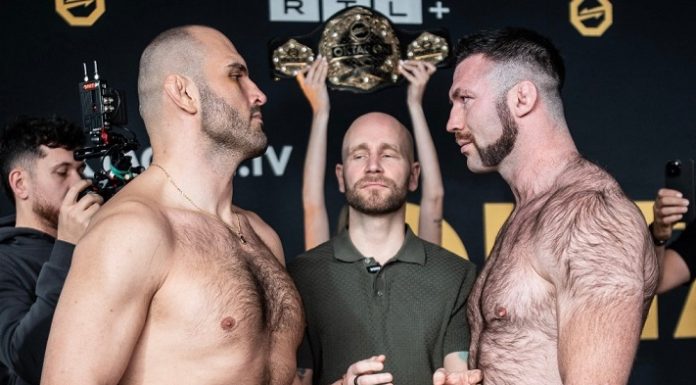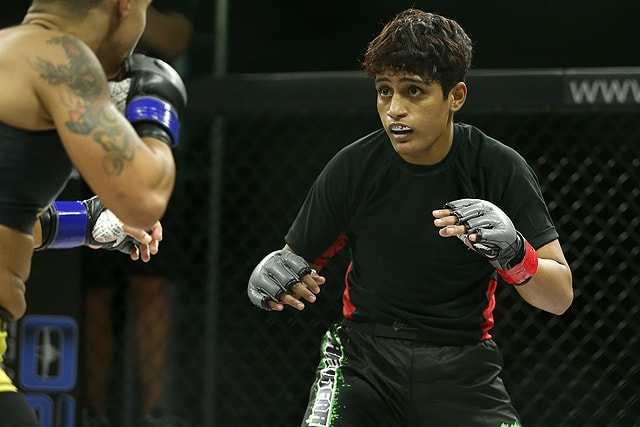
The path of MMA in India has featured many roadblocks and challenges. We will be taking you through a four-part journey to discover the roots of where fighters like Manjit Kolekar and Bharat Kandare came from.
Even today, Mixed Martial Arts is a foreign concept to the Indian population. The sport is very niche and gets zero mainstream attention not just in India, but across the world. So obviously when the sport was introduced in India, the technical support and the foundation required to run the sport wasn’t available in this country. However, this did not stop a few people from taking a dive into the unknown. The people who took the risk have today managed to create a structure around which MMA in India loosely revolves.
Before we analyze that structure, we need to understand two things:
- Since the inception of the sport, the Indian MMA community has failed to create a stable mechanism for the sport. The sport is not organized. Nor has the Indian MMA community created a clear path which one can follow to get into the world of MMA. You start from nowhere and you end up nowhere.
- MMA is not a government-recognized sport in India. That means MMA fighters are not recognized as athletes and aren’t eligible for the same benefits and support that other athletes get from the Indian government. MMA is not illegal, but at the same time, it is not recognized. This lack of recognition has resulted in not having a proper governing body over the sport. This means there is not a single commission that can represent the Indian MMA community to the government. This lack of a proper entity has been the leading factor in creating the current structure of Indian MMA.
What does the Indian MMA structure look like?
The Indian MMA structure is comprised of five pillars:
- Fighters
- Gyms
- Promotions
- Management
- Governing bodies
These five are the basic pillars on which Indian MMA, in fact, MMA in general, stands. Each pillar, with its own identifiable weakness, makes some contribution to the Indian MMA community.
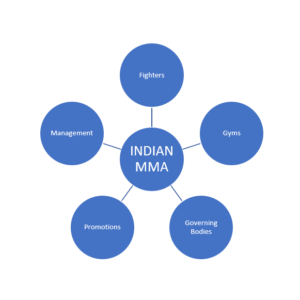
1. Fighters
A sport revolves around athletes. It is the fighters who run the machinery of the sport which generates business. The position of a sport in an area can be easily understood by studying the condition of athletes practicing that sport, the background these athletes come from, and the way they are treated by the people who run the structure of the sport.
The majority of the fighters in India cannot make a living in MMA. Most of them make their switch from a different combat sport to MMA. In fact, the early batches of Indian-born-and-bred fighters were all originally wrestlers or kickboxers.
Fighters in India have time and again complained about mental and emotional harassment from organizations. They are usually signed onto long-term contracts and in most cases aren’t even given a copy of the contracts. They are sometimes even subjected to bullying and are forced to share a certain amount of their income with sponsors of the gym they fight for.
Revealing the condition of fighters in India, Invicta FC fighter Manjit Kolekar said, “In India, the fighter treatment on every end is pathetic. Promotions fail to understand that we are humans and not machines. Their expectations are unrealistic. Outside India, we are treated with respect. We get a basic health checkup, even if we win and aren’t hurt badly. We also get medical coverage, and our health is taken care of. However, in India, once the fight is over, most promotions don’t even bother to check on us.”
Kolekar’s opinion is seconded by many of her counterparts. In fact, some fighters in India are also charged money if they want to fight.
ONE FC fighter Rajinder Singh Meena said, “When we go outside India, we understand how fighters are actually treated. Here in India, a fighter has to pay for everything starting from camp and nutrition to traveling. Everyone comes and asks for money from us. It is only if we win that we can make a little profit.”
Most fighters in India are not highly educated. They cannot read the legal contracts. Hence, when they sign a document they usually are not aware what terms and conditions they are agreeing to. However, this is only one aspect of the problem.
“The problem isn’t solely about us misunderstanding the contracts. There are very few opportunities available for fighters in India. Most fighters are usually frustrated because they don’t get a chance to fight and showcase their talent. On top of that, they have no support from their family. So the very thought that they’ll get to fight excites them and they end up signing contracts,” Manjit Kolekar said.
It isn’t uncommon to find an Indian fighter stuck with a long-term contract which blocks them from taking newer opportunities. Such contracts have played an important role in shaping the current scenario of Indian MMA, a topic which we will soon cover.
The Indian MMA community has zero money for fighter investment. The community isn’t backed by any big sponsors willing to invest money in the fighters. Therefore, the majority of the fighters cannot afford to go outside India and obtain specialized training.
This has resulted in fighters not being able to understand the way a good MMA fighter trains, which leads to most Indian MMA fighters being one-dimensional.
At least on paper, this looks like the core issue, but gym-owner Nitesh Yadav adds, “The entire one-dimensional issue could have been easily tackled if the gyms allowed their fighters to train at other places and enabled them to develop skills that they could not in their own gyms. However, the Indian MMA community is so fragmented that the entire culture of teaching new skills to a fighter from another gym is non-existent. This division has cost a lot to Indian MMA fighters.”
2. Gyms
Gyms produce fighters. Gyms provide a fighter with the training required to become an MMA fighter. In India, gyms can be classified into two kinds:
Coach-led gyms
Fighter-led gyms
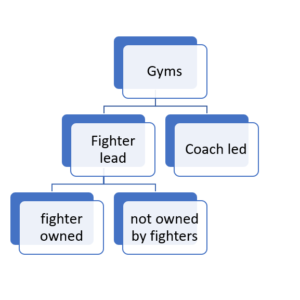
During the early days, there were only gyms led by coaches. However, as the popularity of the sport grew, more and more gyms started adding MMA to their activities as they wanted to attract clients. This resulted in them hiring fighters who could help create MMA camps in their gyms. Let’s take a closer look at the two types of gyms:
Coach-led Gyms
In these gyms, as the name suggests, the coach not only designs the training schedule but also owns the gym. These gyms usually also act as training camps when Indian fighters have to go for major fights. Usually, these gyms also develop great fighters.
They manage fighters, train them, employ them and in some cases even provide a place to live. In fact, the first batch of international Indian MMA fighters were all from coach-led gyms.
Jitendra Khare, the owner and head coach of Evolution Combat Sports Academy, said, “I have traveled to the USA, Thailand, and Brazil to learn the art of Mixed Martial Arts. This has not only made me aware of the international MMA scene but also given me access to some of these promotions. Hence, I can get my fighters fights on the international MMA circuit.”
During the Indian MMA market crash of 2013-2014, it was gyms like Evolution that kept the Indian MMA scene alive by sending their fighters abroad.
Coach-led gyms are also considered stable because the one who teaches you is not only a trained professional but also has to keep his business alive. That means they most likely won’t leave the place overnight and will also provide proper guidance.
Fighters tend to change gyms very frequently. If you go to a fighter-led MMA gym, you run a certain degree of risk because there is definitely a probability that the fighter leaves the gym. However, a head coach and owner of the gym won’t be closing down the gym if a fighter leaves as they too can train their clients.
Fighter-led Gyms
There are two types of fighter-led gyms: those owned by fighters and those not owned by fighters.
Let’s starts with fighter-led gyms owned by fighters.
Fighter-led and owned gyms at the moment are some of the most sought-after gyms by Indian MMA fighters. This is so because these gyms understand the position of Indian MMA fighters and are comparatively more open to fighters’ demands.
Nitesh Yadav, the owner of Combat Sports Academy, said, “In India, there is no single gym which can provide every skill required to become a successful MMA fighter. Gym owners like me, who actively fight, can understand this. Hence, unlike other gyms, we allow our fighters to train at different places and even try and provide them early support, which is required to make a successful career in sports.”
The second type of gym is a fighter-led gym which is not owned by fighters. These types of gyms are the most popular MMA gyms in the country. These gyms were originally created for fitness purposes but as the sport gained popularity, they started hiring MMA fighters to provide training in their gyms.
The problem with such gyms is that they make many promises to the MMA trainers, which they later cannot fulfill. This causes the trainers to leave their gyms and thus, the entire MMA structure crashes, resulting in heavy losses for the gym owners. Most of these gyms do not adhere to proper regulations too. However, such gyms do provide fighters a source of income.
Fighters get the opportunity to work and train at the same places. There have been instances where fighters have tried to unite under a single brand but have failed to continue with training sessions at the gym failed to generate enough funds to pay them.
Fake Gyms
As MMA gains popularity many gyms and clubs are masquerading as training centers. Many of them are even backed by “certificates” from “official organizations.” We will talk about these “certificates” later, but for now, let’s try and understand how one differentiates between a fake and a legit gym.
Jitendra Khare says, “In the age of the internet, I find it astonishing that people are so easily scammed. They need to inquire. If a gym is boasting that they can train people in MMA, then who is the head coach? What are the credentials of that coach? Who is he? Has he ever fought an MMA match before? Do basic research before joining a gym.”
3. Promotions
Mixed Martial Arts promotions can be classified into two kinds: amateur and professional.

Amateur
Amateur promotions in India can be further classified into two kinds: ones which governing bodies run and the ones which run independently. Alan Fernandes, the founding member of All India Mixed Martial Arts Association (AIMMAA), says “MMA is known now in the country. Something that was unheard of when I first started competing in 2004. MMA is here to stay but it is a serious sport and people cannot judge it just as an entertainment sport or a quick way of making money. Indian MMA will only grow for the better if it is regulated, sanctioned, and governed by individuals closely related to the sport with a national body like AIMMAA. I personally feel there is a lot of work to be done but we are on the right track for sure. There are finally divisions of amateur and professional fighters in India.”
Governing Body Amateur Leagues
Two of the largest MMA bodies in India, All India Mixed Martial Arts Association and All India Mixed Martial Arts Federation, run their own national championship in India. The two bodies host the independent national championship sanctioned by different governmental bodies. Every year aspiring fighters take part in the national championship to try and create a name for themselves in the independent Indian MMA circuit.
Independent Events
These are events organized by independent promoters. The independent amateur scene is a bit murky as there is no proper regulation to it. However, some promotions have managed to establish themselves as good amateur leagues and decent training grounds for Indian MMA fighters. These promotions keep on popping up here and there. The owner of Evolution Gym, Jitendra Khare, said “If we have to develop quality MMA fighters in India, we need a defined amateur program and league for future fighters. Amateur fights help in developing their skill set and evolve as a fighter.”
Professional
At the present moment, the professional MMA scene in India is dominated by Super Fight League (SFL). Since 2017, SFL has been hosting an annual league which begins in early February and goes on till mid-March. Avi Mittal, Director of Super Fight League, says the organization is glad that they have this support. Opening up on this condition he says “We are glad and are proud to be backed by strong sponsors as an Indian MMA organization. This is because they have a belief in us and we do our best to live up to their expectations. We always support all our fighters Indian or foreign. We believe in giving them an opportunity to showcase their talent on this national platform and let the world acknowledge their talent.”
Rajinder Singh Meena says, “SFL is the only major player in the Indian market today. However, they just host events in the league. For the rest of the year, we see a random promotion come and host an event and then disappear. There is no consistency in the market. On top of that, promotions expect us to sign long-term contracts with them.”
The owner of Full Contact Championship (FCC) and one of the founding members of the Indian MMA community, Prashant Kumar, too, seconds Meena’s opinion.
“There are very few opportunities available in the Indian MMA market. The market has no money,” Kumar said. Elaborating on his own position and that of most other promoters, Prashant adds, “One needs to have the backing of a strong sponsor to host successive events. MMA isn’t generating any profit at the present moment, which means not many sponsors are available. Therefore, most promoters are forced to spend large amounts of production cost from their own pocket. When ticket sales and sponsorship money fail to recover that amount, most promoters stop producing events after one attempt or go for a long break, save money, and then host more events.”
The entire process of generating the production costs takes a lot of effort. However, even if a fighter is lucky enough to manage to get a fight with a promotion, that does not guarantee that the promoter will pay them.
Opening up about her past experiences, Manjit Kolekar said, “There have been instances where I have been promised stuff which I have not received. Forget the “win bonus” they promise, promotions have failed to give me basic fight purse money. We pay for camps, have to take care of nutrition and invest in other things only to be denied basic pay.”
A number of Indian MMA fighters have faced this problem at some or the other point. Mayur Bansode points out that the major problem was misguided expectations of the MMA market.
Bansode said, “Promoters need to think before they promise stuff to MMA fighters. Staying realistic is necessary. MMA has no major sponsor; hence, one cannot simply promise a bunch of things to fighters and then back off. It is necessary that before a person jumps into the MMA business, he/she studies the market.”
Another major issue faced by most events is fighter safety. One can possibly even ignore the fighter pay, as almost everyone involved knows that Indian MMA has no money. However, when a fighter enters the ring, he literally puts his body on the line. Under no circumstances can fighter safety be ignored. However, the casual attitude most promotions have towards it is scary. Prashant Kumar says, “The most basic requirement from any event organizer is that there should be an ambulance in the arena, a doctor and a hospital nearby to make sure fighters stay safe. They put their lives on the line. If anything were to happen to even a single MMA fighter the consequences for the entire community will be severe. I have been to a few MMA events in India and the fighter safety in there is pathetic. Referees do not know how to do their job and allow fighters to take unnecessary career-threatening damage.”
https://www.youtube.com/watch?v=INSF40Yxzz8
The above video stands as a perfect example of how fighter safety is neglected in India.
Responding to the criticism, one of the founding members of All India Mixed Martial Arts Association and SFL referee, Alan Fernandes says “Criticism is always there whether you do a good job or have a bad day at refereeing. The fact that I get to referee is a privilege and I grow with criticism. I take pride in my work. Criticism only helps me, it doesn’t demoralize me. It also keeps oneself on their toes…shows your work is being watched and judged by one and all (even when they have no clue about the nuances of the sport). For the record, referring is a thankless job but I do it through my passion for the sport. Criticism is a tiny snippet of the kind of abuse and wrongful accusations we as refs get in line with our job and people forget that we are human too.”
The quality of refereeing and fighter safety have been among the most talked about topics in the Indian MMA community. This has resulted in a slow but steady change in the attitude of organizers.
Prashant adds, “At FCC events, I make sure that there are an ambulance and a doctor present near the ring. The nearest hospital too has a deal with us, and we also cover the damage a fighter takes in the fight.”
This policy is also followed by Yoddha Fighting Championship (YFC) and some other major promotions in India. However, Nitish Yadav, SFL fighter, said “Almost all of this is on paper. A fighter needs help from the promoter not before but after the fight. They need to take responsibility. We are fighting for them, under their banner. This is the minimum they owe to us.”
4. Managers
Managers play a very important role if a person wants to make professional combat their career. They get you sponsors, fights, help you with legal work, explain the contracts and also make sure their fighters don’t end up being blocked or scammed by organizations.
Most gyms in India, early on in the career of a fighter also act as managers. For example, Jitendra Khare gets his fighters events on the international circuit and also takes care of their paperwork. He says, “I get my students fights, take care of sponsors and talk with promotions early in their career. I do the job of a manager but that is only till the time they begin to get big contracts.”
However, their role in the career of MMA fighters has been largely criticized by most fighters. Manjit Kolekar says, “A fighter survives on their talent. Promotions approach them based on a fighter’s record and his achievements. If you work hard, you can easily become very successful in this field. In fact, managers charge unnecessarily high fees and add to the mental pressure. Instead of helping us, they join hands with promoters and block fighters. Yes, an MMA fighter needs a manager but not from the very first day. Today I fight in foreign promotions, which means I have to deal with a lot of paperwork. Hence, I need a manager but early in your career you don’t need one.”
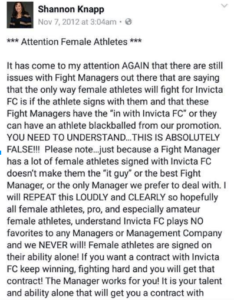
Rajinder Singh Meena, when questioned about the role managers have played in his career, informed he was approached directly by ONE FC and no manager played a role in getting him a contract said, “A member of ONE FC’s management approached me on Facebook. No manager was involved in any conversation I had with ONE FC. You don’t need managers early on in your career. You need to work hard.”
However, denying the role played by managers would be wrong.
Both Manjit and Rajinder were the best Indian MMA fighters and were exceptionally skilled. Therefore, the two were contacted directly by international promoters. Most other fighters will need managers, maybe not early on, but they surely will. That being said, the entire structure of management needs to change.
Managers clearly need to specify to MMA fighters what their job will be and not just use vague terms to keep them in the dark. Also, fighters should go for a background check before appointing someone as a manager. Mayuri, Manjit’s friend and also her unofficial manager presently, said “There needs to be a bond of understanding between the manager and the fighter. Managers need to understand that fighters are human beings too and need to offer them the necessary support. Yes, MMA fighters need managers. Maybe not early in their career, but they sure do.”
Mayuri essentially much summed up the entire position of Indian MMA managers in India.
Somesh Kamra, the famed manager of the first-ever Indian UFC fighter, Bharat Kandare, agrees that fighters in past have been treated badly and have been cheated.
“If you study the history of individual top Indian MMA fighters you can easily understand that at some of the other point they have been cheated by their managers. Their anger is justified. However, if we as a community have to grow we need to learn from our past, be more careful and grow beyond our past mistakes,” Kamra said.
5. Governing Bodies
MMA is not a recognized sport by the Indian government. That means, even I could start a body today and call it the official governing body of MMA.
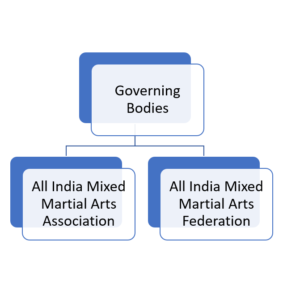
However, over time, today India has evolved two major MMA bodies; AIMMAA and AIMMAF. AIMMAA has been a part of MMA since the very inception of MMA in India. AIMMAF was created in 2016. A detailed study of the two bodies will be covered in the upcoming parts of the write-up.
Some organizations attach themselves to these bodies, others create their own bodies and yet others just don’t care about sanctioning bodies. These two organizations have contributed to the world of Indian MMA.
- How did Indian MMA end up in this state?
- Who was the brain behind these two bodies?
- How did MMA begin in India?
- How did Indian fighters get international attention?
The answer to all these questions is history. The entire history of Indian MMA will explain how the sport was established, and how this structure was created. We will cover the history of the sport in 5 parts, each part covering one chapter of this fascinating story.


















